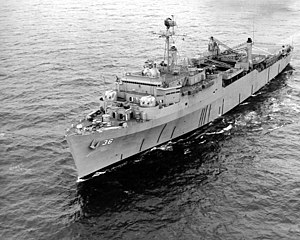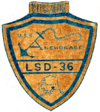USS Anchorage (LSD-36)

USS Anchorage (LSD-36), a US Navy dock landing ship, underway off Pascagoula, Mississippi (USA), while running trials on 27 January 1969.
|
|
| History | |
|---|---|
|
|
|
| Name: | Anchorage |
| Namesake: | City of Anchorage, Alaska |
| Awarded: | 29 June 1965 |
| Builder: | Ingalls Shipbuilding, Pascagoula, Mississippi |
| Laid down: | 13 March 1967 |
| Launched: | 5 May 1968 |
| Commissioned: | 15 March 1969 |
| Decommissioned: | 1 October 2003 |
| Struck: | 8 March 2004 |
| Identification: |
|
| Motto: | 1st of its class |
| Honors and awards: |
|
| Fate: | Sunk as a target, 17 July 2010 |
| Badge: |  |
| General characteristics | |
| Class and type: | Anchorage-class dock landing ship |
| Tonnage: | 5,570 long tons deadweight (DWT) |
| Displacement: | |
| Length: | 553 ft (169 m) |
| Beam: | 84 ft (26 m) |
| Draft: | 19 ft (5.8 m) |
| Installed power: |
|
| Propulsion: |
|
| Speed: | 20 kn (37 km/h; 23 mph) |
| Boats & landing craft carried: |
|
| Troops: | 320 |
| Complement: | 24 officers, 300 enlisted |
| Armament: |
|
| Service record | |
| Operations: |
|
| Awards: |
|
USS Anchorage (LSD-36) was the lead ship of the Anchorage-class dock landing ship of the United States Navy. In the ship's 34 years of service, she completed 19 deployments in the western Pacific and became the most decorated dock landing ship on the west coast.
Anchorage was awarded to Ingalls Shipbuilding in Pascagoula, Mississippi on 29 June 1965 and her keel was laid down on 13 March 1967. She was launched on 5 May 1968; sponsored by Mrs. Alexander S. Heyward, Jr., the wife of Vice Admiral Alexander S. Heyward; and commissioned at the Norfolk Naval Shipyard, Portsmouth, Virginia, on 15 March 1969, Captain Percy Stuart Beaman in command.
Outfitted with a large floodable stern section accessed through an enormous operable stern gate, Anchorage served as a launch platform for large landing craft, such as the LCU, as well as a "boat haven" to shelter other small craft utilized in an amphibious landing. The ship was able to provide a minimal degree of naval gunfire support through the use of two sets of twin 3 in (76 mm)/50 caliber guns mounted on the 02-level fore and aft. In later years these guns were removed to be replaced with Mk-38 machine guns and two Phalanx CIWS for missile defense. In its final decade of service with the US Navy, it functioned primarily as a platform for two LCAC hovercraft landing vehicles and embarked Marines.
...
Wikipedia
